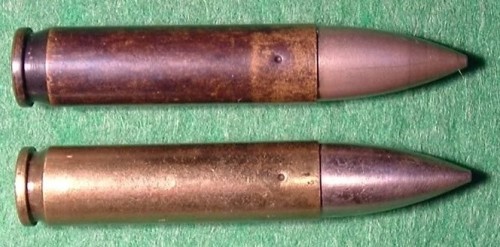The Winchester-Burton Machine Rifle
The Winchester-Burton Machine Rifle, also known as the Winchester Model 1917, was developed by Frank F. Burton who had designed Winchester’s earlier commercial semi-automatic rifles. Little documentation on the rifle survives, but it was believed to have been intended for use as an anti-balloon weapon. Observation balloons dominated the Western Front and were instrumental in directing artillery fire and spotting enemy troop movements. These hydrogen-filled static balloons became a key target for airmen on both sides. As such, they were often heavily defended by anti-aircraft guns and even fighter cover. They were initially attacked with conventional ammunition which proved ineffective. In 1916, a French officer Yves le Prieur designed an electrically triggered rocket system which could be mounted on a fighter plane’s wings. The limited range of these rockets meant a better solution was still needed.
By 1917 tracer and incendiary ammunition was being developed; the first to be deployed was the British ‘Buckingham’ ammunition which used phosphorus. This was originally developed in response to the German zeppelins which bombed Britain during the early years of the war. Burton’s automatic rifle was chambered in the .345 Winchester Self-Loading Rifle cartridge - a rimless, modified version of Winchester’s .351 WSL cartridge which had an incendiary spitzer projectile.

.345 Winchester Self-Loading Rifle cartridge (source)
Burton’s machine rifle used a blowback action and fired from an open bolt. The gun weighed 10 lbs. (4.5 kg) and its overall length was 45.5 inches (116 cm), making it slightly shorter and significantly lighter than the later Browning Automatic Rifle. It was select fire with a cyclic rate on automatic of 800 rpm. The rifle had two triggers with the first allowing semi-automatic fire while a second, below the trigger guard, could be pulled at the same time enabling fully automatic fire. It fed from two vertical 20-round magazines which fitted into the receiver at a 60° angle. This allows for an uninterrupted sight picture along the barrel through both a v-notch sight between the two magazines and also through the rear aperture sight (see image #4). The rifle fed from one magazine at a time, once the first magazine had been expended the operator would switch to the other. The magazines had a pair of locking catches, the first was a storage position which was too high in the magazine housing for the bolt to strip a round out of the magazine. The second position allowed the magazine to be fully inserted into the weapon and allow the bolt to strip rounds from it. This system was intended to give the airmen operating it a magazine system which would not require them to fully remove a magazine to reload the weapon. While the magazine system seems convoluted the logic is sound.
The weapon had a number of interesting features: it was ambidextrous with its charging handle located beneath the receiver and it ejected spent cases downwards - much like a Browning SA-22. The weapon’s barrel was finned to aid cooling and the fore stock had a finger groove as well as a ring mount to attach it to the fuselage of an airplane. Burton’s Machine Rifle also had an in-line stock, a tubular receiver, its trigger group integrated with the pistol grip, raised sights (with the rear sights folding), and an interchangeable barrel (removable by unscrewing a stop screw and then unthreading the barrel) to allow the weapon’s role to be switched from air to ground specialties. A ‘ground’ barrel was also provided which had an additional bayonet lug (see image #2). When considering these features and the weapon’s intermediate ammunition Burton’s machine rifle can be described as one of the first true assault rifles.

A Winchester-Burton Machine Rifle, fitted with ‘ground’ barrel, held by the Buffalo Bill Center of the West’s firearms collection (source)
The impetus behind the design of a dedicated machine rifle for attacking observation balloons is unknown. One theory might be that it was to allow the aircraft’s main guns to be loaded with conventional ammunition for engaging enemy fighter aircraft while Burton’s machine rifle could be handily deployed by pilot or an observer against a balloon. During the First World War fighter pilots were prohibited from using incendiary ammunition against other planes and troops by the Saint Petersburg Declaration of 1868. This declaration outlawed the use of explosive projectiles weighing less than 400g against combatants; however, incendiary ammunition could be used against balloons and zeppelins. Perhaps it was envisioned that the dedicated balloon-busting machine rifle would offer pilots flexibility and allow them to engage all likely targets. The Burton machine rifle’s proposed implementation as a ground weapon probably followed once its potential was realised. If the magazine system had been further simplified it would have been a useful infantry weapon.
While the weapon was allegedly tested at the Springfield Armory, the records of the testing have been lost; it was not adopted and the project did not progress beyond the prototype state. The only known remaining example was part of Winchester’s collection and is now part of the Buffalo Bill Center of the West’s firearms collection. The Winchester-Burton Machine Rifle is a weapon in desperate need of further research.



